Best Men's Overcoat Styles and How to Wear them
2022-03-16
With all the men's winter fashion options open to men, by far the most overlooked is overcoat style. The most common question asked “is an overcoat too formal” for men’s outerwear. In this mens coat guide, we're hoping to show that there is often no better way to make a fashion statement than including the distinct looks of a modern overcoat in your wardrobe, regardless of the season.
Men’s Overcoat Style
Guide While overcoats remain a distinct style, there are several types of mens coats to consider when selecting an overcoat. Investment in classic men’s coat styles can last you many years, but selecting one without care can instead buy you a hanger placeholder that gathers moths in the back of your closet. Let's first take a look at the different types of overcoat styles currently available.
Pea Coat
The mens wool pea coat is the first of our navy overcoat styles. This outer coat is known for its broad lapels, large buttons, vertical slash style pockets, and double-breasted fronts. The coat itself extends to the thighs and provides excellent cover from weather. The origins of the name are either based on the American claim that the cloth used was the same as pilots jackets, hence “P-coat,” or from the Dutch theory that the cloth used was called pij, pronounced as “Pea.” The Pea Coat has thick material, and is at home in both professional and casual environments.
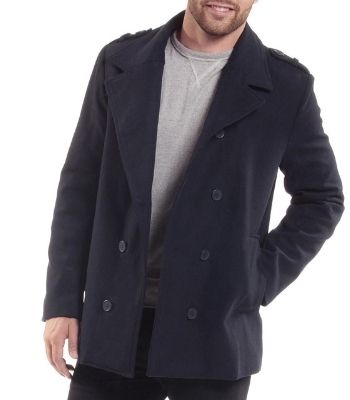
Car Coat
The car coat is going through a revival of sorts since the turn of the century. Defined by its wide cuffs, hip length and A-line cut, this coat was designed for a wide range of movement while driving. Today it remains a recognizable single breasted wool overcoat, and features diagonal front pockets. Originally made for drivers, it started appearing around the same time as early automobiles. It became necessary to design a coat that offered wind protection and warmth while also allowing for a full range of mobility.
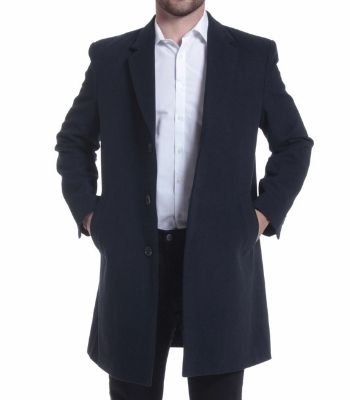
Duffle Coat
The duffle coat is a more casual top coat. It is a British style long coat from the royal navy and was designed to be fastened easily while wearing gloves. It can be identified by its broad shoulder yoke, button tabs, patch pockets and a hood. The coat is single breasted and hip length typically. One of the more distinct features are the coat’s loop fasteners and toggles known as walrus teeth. Unlike the other coats on this list, the duffle coat is tailored more towards the casual or everyday style. Its bright characteristics and eccentricity suit a dressed down approach much better than formal situations, but because it is so distinct, the style of this coat often comes down to the individual. It is one of the only mens dress coats with a hood.
The Trench Coat
The trench coat was named after the World War 1 trenches it was worn in and is one of the more recognizable mens long coat styles. It is equally easy to wear in everyday situations or for formal occasions. It is defined by its epaulets, napoleon collar and wide lapels, storm flaps, integrated waist belt, buckled sleeve straps, and below the knee length, making it the quintessential military style overcoat. It is usually double breasted with large metal, plastic, or wooden buttons. The trench coat is an elaborate jacket that uses several elements to create a weather worthy garment that is also elegant and stylish.
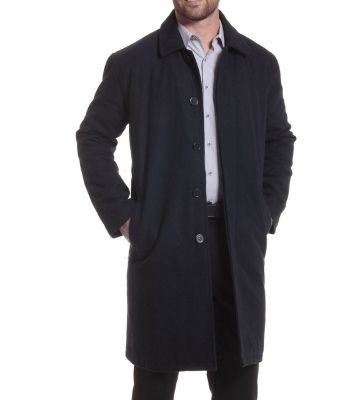
Chesterfield
The Chesterfield style coat has always been a men’s formal overcoat. This Victorian style overcoat was in the wardrobe of every man in the mid to late 1800s. This replaced styles in the earlier part of the century where clothing was designed very close to the body and meant to be worn inside and out. In many ways, the Chesterfield is one of the first overcoats introduced. The coat is defined by a short notched lapel, a single breasted fly front, a velvet collar, no cuffs, a single back vent, and the lack of a waste for additional room. The coat hangs at thigh length.
Polo Coat
The Polo Coat originated in England and is a loose-fitting, casual style of overcoat. Originally instead of buttons, the coat featured only a belt as it was meant to be put on and removed quickly for polo players waiting to play. Once it became more popular in the 1950s, the belt was replaced with buttons and a double breasting. Other features can include a half belt, set-sleeves, an Ulster collar, and patch style pockets. Some coats will also feature an inverted pleat on the back.
How to Wear a Men’s Overcoat
While the function of each overcoat is similar, there are slight differences that should be considered. In this overcoat fit guide, consider not only what each overcoat can offer, but also your needs for the coat. A stylish overcoat is only as stylish as the ensemble, so also consider what to wear with an overcoat.
How to wear a Car Coat
Car coats are designed to be worn looser due to their a-line shape and are usually single breasted. It’s a formal looking jacket that is better suited for casual wear like jeans, sweaters, and sneakers. Because of the looser silhouette, experimentation with what you wear underneath is encouraged. When worn open, it can highlight your wardrobe and when buttoned car coats provide a minimalistic and clean presentation.
How to wear a Duffle Coat
The duffle coat isn’t meant to be a tailored fit, so your options are flexible. Nonetheless, mobility and restrictions should be aspects of selecting the right size. Since the coat isn’t meant to be form-fitting, this jacket is perfect for heavier builds as well. This jacket’s relaxed look answers the question of how to wear an overcoat with jeans, though it also matches well with cords, large boots, thick scarves, and under jackets.
How to wear a Pea Coat
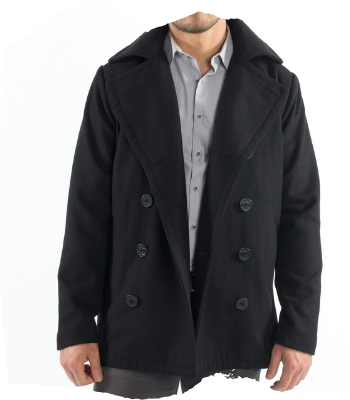
The peacoat is one of the most common couple-breasted overcoats found in mens coat style, and looks good with just about any garment. You can wear the collar popped or down, with a turtleneck or a sweater, with jeans or formal pants, and with sneakers or loafers. The peacoat remains one of the most versatile pieces on this list, and is a great option for a varied wardrobe. Just remember that its shorter length works better for slimmer builds, and that for especially cold weather, a longer jacket may be the better choice.
How to wear a Trench Coat
Despite being one of the warmer coats on this list, trench coats can be worn in warmer weather as easily as winter. In the autumn and spring, wear the coat open with a slightly popped collar and ground the color of the trench coat with dark laces and darker earthy colors. In the winter, wear it with layers. The trench coat’s works best with a slimmer build but also works well with larger gentlemen. How to wear a Chesterfield The Chesterfield remains one of the more formal entries on this list and is the perfect coat to wear with a suit and tie. Additional accessories can include a thin scarf, leather gloves, a handkerchief, and a formal hat. Because of its middle-leg length, it’s equally suited for tall and short, heavier and slim.
How to wear a Polo Coat
The polo coat is an interesting entry on this list in that it has many of the aspects of a formal coat but doesn’t pair well with formal situations. It has sharp moldings, is double-breasted, and works well with formal wear as it does jeans and trainers. But polo coats usually come in brighter colors, and because of this tends to clash with darker colored business suits.
How to Style an Overcoat
Now that you’ve decided to get an overcoat, you need to know how to choose an overcoat that is right for you. How should a coat fit? How long should a men’s overcoat be, and should a coat be fitted or loose?
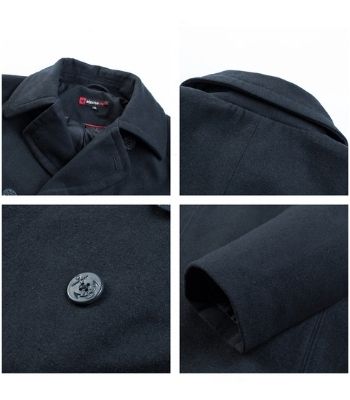
- Fabric
Make sure to get a coat that is 100% wool if you plan to wear your overcoat for more than a couple years. A good rule of thumb is the heavier the coat, the longer it will last.
- Silhouette
With overcoats, the silhouette matters more. Consider what you will be wearing under the coat, as the bottom should cover the bottom of your upper garment. Belts can add bulk, but when tied can create a slimmer figure. During colder times, your under-wear will be bulkier, so consider a looser coat. Sleeves Just like the silhouette, the sleeves should cover the bottom of the sleeve of what you’re wearing under the coat. This is a better look, and will keep you warmer.
- Length
Overcoats are usually long garments, but vary slightly. Longer coats are better for thicker builds and tend to be warmer. Shorter lengths are better for trimmer builds and tend to be cooler.
- Color
In general darker colors like navy, gray, and black are adaptable, more easily matched, and work better in formal situations. Light colors like camel tend to be more striking, and work better with casual coats like the duffle or peacoat.
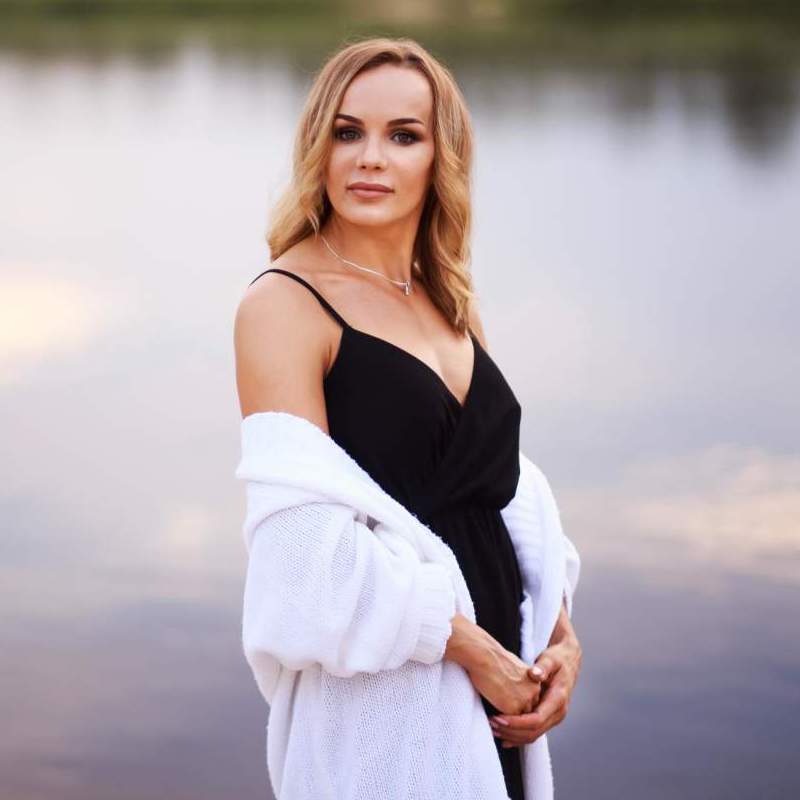
Mariam Simmons
Mariam Simmons is a fashion enthusiast and Content Manager at Alpine Swiss. She loves traveling to the world’s top stylish destinations and gets inspired to create helpful fashion and lifestyle guides. With over a decade of writing experience, her main goal in creating content is to ensure readers learn something useful and provide value instead of noise.

